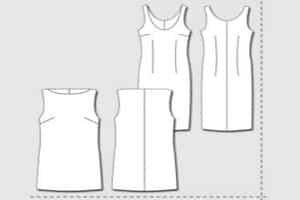What is the Male Gender of Seamstress?
Have you wondered what the male gender of seamstress could be? English is a gendered language with gender roles and binaries for just about anything. Any profession and professional can be defined according to what their trade and gender are. We use different terms for different people even if they belong to the same trade.
For ages, sewing has been considered a female-centric trade. This is why the term seamstress has been very popular in English diction. In the last century, men have started showing interest in fashion, sewing, clothes, and threads in the first place.
The lack of men in the trade in the initial years of the English language made the term seamstress popular. However, do you want to know what you can call a man who sews clothes the way a seamstress does? Let’s find out.
Table of Contents
- 1 Who is a Seamstress?
- 2 Who is the Male Counterpart of Seamstress?
- 3 Gender-Neutral Terms in the Trade
- 4 Differences Between a Trailor (Sartor) and a Seamstress
- 5 Some Famous Sartors
- 6 How These Sators Affected Gender Identity
- 7 Frequently Asked Questions
- 8 Work or Job Titles
- 8.1 Locations
- 8.2 Training and Qualifications
- 8.3 Dressmaker’s Job Description
- 8.4 Set of abilities
- 8.5 Responsibilities & Primary Responsibilities
- 8.6 Secondary responsibilities
- 8.7 Background Information
- 8.8 Job Description Tailor
- 8.9 Step-by-Step Tailoring
- 8.10 Job Specific Qualifications
- 8.11 Typical Working Environment
- 8.12 Salaries that are made to order
- 8.13 Prospects for the Future
- 8.14 Wrapping Up
Who is a Seamstress?
A seamstress is a woman who earns her living through sewing. She is known for her skill of working with clothes. A seamstress mends and sews all fabrics and creates her own patterns and embroidery on clothing.
The trade associated with a seamstress is vast. A seamstress can do embroidery work for personal clients. However, she can also be hired by a company to manage particular clothes. A seamstress can either be a mender or an artist. The label she chooses for herself depends on her level of expertise in each sewing trade.
A seamstress can earn according to the amount she puts into her work. For example, a seamstress who specializes in mending clothes or adding buttons will not earn a lot. However, a seamstress who specializes in embroidery and making their own clothing line can earn heavily.
Who is the Male Counterpart of Seamstress?
Traditionally, the term tailor is linked with a man who stitches and sews for a living. There is more or less no distinction between a seamstress and a tailor. The only difference is that the former belongs to the female gender and the latter belongs to the male gender.
Some people also like to refer to a tailor as a sartor. Sartor appears to be the direct male derivation of the term seamstress. Therefore, sartor is the right choice for a purely masculine term used for male seamstresses.
Tailor is an excellent term to signify a man who indulges in the trade of fashion, clothes, mending, and stitching. However, as men have taken over the business, it seems to have become a collective term for all genders.
A tailor can be regarded as a gender-neutral term instead of a male-establishing term in the fashion industry.
What Does a Tailor Do?
Just like a seamstress, a tailor’s job can be diverse. The kind of work each tailor does depends on their level of expertise and choice of craft. Like seamstresses, a tailor could either specialize in mending clothes or embellishing clothes with heavy embroidery.
How much a sartor earns throughout his day also depends on their work. Just as seamstresses, a tailor who specializes in mending will not be paid a lot. However, a tailor who specializes in sewing their personal clothing line can earn a lot.
A tailor can serve their own client through personal trade. However, they also have the option of working with a fashion company as house tailors or a clothing store depending on their skill level. This way, a tailor will always have a steady profit because of a steady flow of clients. One thing is sure, a tailor will always find work, just like a seamstress.
Gender-Neutral Terms in the Trade
The trade of a seamstress or female tailor has expanded over the years. Therefore, the English Language needs to adopt some gender-neutral terms.
After all, studies show that there are more than two genders. Moreover, there seems to be no need to specify a professional’s gender while referring to their professional achievements.
The English Language itself has been evolving through the years and making space for more gender neutral-terms. While the old days use to adapt the male title by default for any profession, that is not the case in many professions. Mending, stitching, and sewing fabrics are some of those professions.
In the fashion industry, the primary gender-neutral term used for someone who works the sewing machine to make additions and alterations to fabric is stitcher.
Other gender-neutral terms used in the trade are sewer, sewing machine operator, and seamster. Of course, the generally masculine term tailor is also used as a gender-neutral term in the current days.
The term seamstress is held for women and the term sartor is held for men. However, every other term used for a person who performs mending, hemming, and alterations to fabrics is a gender-neutral term.
With the help of gender-neutral terms in the trade, we can help create an equal professional environment. Using words such as seamster, stitcher, and sewing machine operator reduces the differentiation between men and women. Moreover, they also make space for non-binary and trans persons in the trade.
Differences Between a Trailor (Sartor) and a Seamstress
Most people use the terms tailor and seamstress interchangeably. This is because of the term tailor has no gender-specific intention. While the professions are the same, only a few differences are visible. Therefore, we will compare the terms, titles, and responsibilities of a sartor and a seamstress.
Both professional titles seem to be almost the same, considering both indicate the same trade only practiced by different genders. Therefore, the roles, responsibilities, journey, expertise, and pay of the two professionals tend to overlap at times. With that being said, we can also note some differences between the two.
Let us look at some of the similarities and differences between the jobs and roles of seamstresses and sartors. This section should clear all doubts regarding who a seamstress and a sartor are.
Terminology
The English term seamstress is a female-specific term, meaning a female person who is in the trade of sewing for a living. The term was first used in the 16th century as a derivation from the old-fashioned term sempster. With just the addition of the suffix -ess, the term got linked to the female gender forever.
The term was first used in the 16th century, the term started gaining fame in the 1850s. It stayed popular for the entire 19th century, as a woman often was a factory worker.
However, with a higher need for women in the medical services, the trade began to perish, and so did the term. It is only after the year 2018 that the term seamstress has started gaining prominence once again.
The term sartor is a Latin term used to signify a male person who earns his living through sewing. Unfortunately, the term is not very popular in English. However, it is widely used in France and Italy both as a name and a professional identity.
Sartor has been derived from the Latin word sartus. This term is the past principle of the word sarciō that literally translates to “I path, and I mend.” Therefore, the term clearly denotes a person who patches and mends clothes for a living.
The term sartor has never been as popularly used as the term tailor. However, due to the term tailor’s gender-neutral usage, sartor is the new appropriate term used for men working with clothes.
Definitions
The definitions of the terms sartor and seamstress have been defined several times in this article. Therefore, we will not get into too much detail here.
The merriam-webster’s collegiate dictionary defines a seamstress as a professionally indulged person in making and altering outer garments.
The same dictionary defines sartor as a literary or funny word used to refer to a man whose occupation is to mend garments.
Work
As mentioned earlier in the article, the works of a sartor and a seamstress are almost the same. Therefore, they can be interchangeable due to the similarity. However, this is a definition from a theoretical point of view. When we look at things from the practical angle, the two professional titles do have some differences in their work.
Seamstresses are known for their detailed work. They are generally employed for being great at the art of embroidery. Seamstresses are known for skilled cutting and pattern making with threads on cloth. They are also hired to use a sewing machine with precision.
A seamstress is generally hired to get into the details of outward aesthetics and beautification. Moreover, seamstresses are great at making garments from scratch.
A sartor or tailor, on the other hand, is known to be very specific in his trade. He generally deals with the formal fitting of a garment. A tailor’s job is mostly to make sure that a garment fits perfectly onto the client’s body. Hence, the term ‘tailor-made’ is used in popular culture to refer to something that fits perfectly.
A tailor or a sartor is generally involved in formal clothing. He is not responsible for the cloth’s external fabrication. A sartor is only concerned with making the garments aesthetically pleasing by making them fit a body properly.
If you have an old garment that needs patching and beautification, you might want to look for a seamstress. However, if you need to fix the fitting of cloth, a sartor will help you best.
Locations
Both seamstresses and sartors have their professional roots in the same industry. If you want to hire a seamstress or a sartor, you will have to look in the textile industry. Both of them are employed at dry-cleaning establishments, clothing stores, textile factories, and various apparel brands.
Most brands hire seamstresses for the early development of their garments. Seamstresses at such companies are hired to make the clothes pretty with embellishments. After that, the tailor takes on the job of giving finishing touches to the sizes created by the seamstresses.
Most clothing stores do not hire seamstresses because they do not need beautification. These stores only require fitting. This is why when you get your clothes altered at a clothing brand store, you will only find a sartor.
A tailor will take poorly fitting clothes from you and make the alternation you need. They can alter the height, length, waist, fit, and overall sizing appeal of a garment. They come at the last step of you wearing the garments.
Training and Qualifications
Both seamstresses and sartors need the same level of training and expertise. They both need to have a high school diploma and some experience in the field of basic sewing. Both can get this training from either formal jobs or personal practices. All that is needed is that they’re good with their work.
You can find professional training and qualifying degrees for seamstresses and tailors. Most global fashion and design schools offer stitching and sewing courses for seamstresses and sartors to perfect their craft.
Formal training is always beneficial, regardless of the trade. However, since sewing is a practical field, practical experience is very important for seamstresses and sartors.
Some Famous Sartors
For centuries, tailoring has been considered a profession for women performing household chores. However, when we look at history, we can see numerous examples of sartors. They are some people who have revolutionized the fashion industry. Let’s explore some such famous sartors.
Hubert de Givenchy

Founder of the French fashion house, Givenchy, Hubert de Givenchy, was a famous French fashion designer. He was known for designing Jacqueline Bouvier Kenney’s professional and personal wardrobe.
The black dress he designed for Audrey Hepburn in Breakfast at Tiffany’s become the quintessential Little Black Dress in America. Even today, Hepburn is considered Hollywood’s fashion icon, all thanks to Givenchy’s design.
Ralph Lauren

Ralph Lauren can be easily seen as one of the most successful fashion designers from The USA. Having started his own eponymous fashion enterprise, he changed the way people dressed in America. He has played a major role in revolutionizing the American style.
Ralph Lauren has been the pioneer of merging the classic American style with refined tailoring and European fashion sensibility. He has made the Ralph Lauren polo shirts so popular that they have become deeply embedded in the American culture.
Giovanni Versace

Giovanni Versace, also known as Gianni Versace, is a renowned fashion designer from Italy. He is the founder of the fashion enterprise Versace, an international success for cosmetics, fragrances, and fashion accessories.
Versace has designed some of the most high-grade costumes in theatre, film, and fashion shoes. Some of this work includes the costumes for the five Bejart Ballet productions and the San Francisco Opera’s Capriccio.
The embellishments designed by Versace ooze sexuality and sensuality. The hemlines he introduced in this clothing have been the most influential and game-changing examples of his style.
Yves Saint Laurent

Another French sartor who made a big name for himself in the fashion industry is Yves Saint Laurent. Having started his eponymous fashion label in 1961, he was among the top fashion designers in the twentieth century.
He was known for his changing style, which led to one after another rapidly changing fashion statements at his time. In his time, he was considered the true innovator in fashion.
As a designer for Christian Dior, he changed the way women dressed with this 1958 Trapeze line. He became the pioneer of the reduction in fabric from the fluid silhouette design in his women’s clothing lines. He is the reason behind most of the fashion choices the modern woman makes on a daily basis.
How These Sators Affected Gender Identity
Fashion icons such as Hubert de Givenchy, Ralph Lauren, Giovanni Versace, and Yves Saint Laurent have made significant contributions to the fashion industry. They have revolutionized styles, set trends, and influenced how people dress. These designers have played a crucial role in challenging traditional gender norms and breaking down barriers related to gendered terminology.
For example, Hubert de Givenchy was known for his collaborations with iconic women such as Audrey Hepburn. His designs transcended gender boundaries and created timeless pieces that were celebrated by people regardless of their gender identity. This type of inclusive approach challenges the need for specific gendered terms in the industry.
Ralph Lauren is another designer who has transformed American fashion by merging classic styles with refined tailoring. His influence reaches beyond traditional gender roles and has contributed to shaping a more fluid interpretation of fashion. By embracing diverse styles and appealing to a wide range of customers, he has helped create an environment where gender-neutral terms feel more appropriate and relevant.
Giovanni Versace’s designs exude sensuality and sexuality while challenging societal expectations around femininity and masculinity. This boldness in design language highlights the fluidity of fashion and encourages individuals to express themselves freely without conforming to strict gender labels. In doing so, Versace’s work challenges the notion that specific terms are necessary based on one’s gender.
Yves Saint Laurent is renowned for his innovative creations that pushed boundaries in both men’s and women’s fashion. He introduced new silhouettes, incorporated menswear-inspired elements into women’s clothing, and challenged conventional notions of beauty. By blurring the lines between genders in his designs, Saint Laurent paved the way for a more inclusive understanding of fashion where rigidly defined terms become less relevant.
The impact of these fashion icons lies in their ability to transcend gendered expectations and create a space where fashion is celebrated as a form of self-expression for all individuals. Their work challenges the need for gender-specific terminology within the industry and supports the adoption of more inclusive gender-neutral terms.
Frequently Asked Questions
Do you still have questions regarding the male terminology for a seamstress? Let us discuss the best answer to your questions in this section.
What is the Term Used for a Person Who Sews?
There are many terms that can be associated with a person who sews and stitches for a living. The renowned term is tailor, which is a masculine noun. However, if you want to get gender-specific, you can use the term seamstress for females and sartor for males.
Can a Seamstress Be a Man?
Seamstress is a term specifically used for females. Therefore, seamstress is a term only used to signify a female who participates in the craft of stitching and sewing. A man indulged in the same profession will have to use other professional terms for himself.
What Is The Better Term – Sartor or Tailor?
If you want to specify that the person you are referring to is male, the term sartor is more appropriate. However, sartor is a dated and literary term and is hardly used in routine English diction. Therefore, to make things simple and uncomplicated, people use the term to refer to a male seamstress. This is the case even though the term can be used for both genders.
What Is the Distinction Between a Tailor and a Seamstress?
Tailor and seamstress are two different jobs that are frequently confused. Although many of the criteria of the two vocations are similar, there are a few variances in the activities that each performs.
Terminology
A female seamstress is referred to as a “seamstress.” The male equivalent to a seamstress is known as a “seamster.” The term “tailor” has no gender connotation.
Definitions
A seamstress is a “woman whose occupation is sewing,” according to “Merriam-Collegiate Webster’s Dictionary.” A tailor is “a person who makes or alters outer clothing as a profession.”
Work or Job Titles
A seamstress’s (or seamster’s job entails using patterns, cutting fabric, and stitching by hand, machine, or both. Seamstresses may create and stitch a wide range of clothing, accessories, upholstery, and other items. Tailors specialize in making, altering, and custom-fitting clothes. Tailors specialize in formal dress and special occasion outfits, such as wedding gowns.
Locations
Textile manufacturers, dry-cleaning shops that offer repairs and adjustments, garment stores, and various departments of apparel manufacturing corporations employ seamstresses and tailors. Many tailors and seamstresses offer custom work to the general public.
Training and Qualifications
A high school diploma and some sewing experience are normally required to work as a seamstress or tailor. Although many fashion schools and colleges provide courses and certificates in sewing and tailoring, much of the training for both disciplines is on the job.
Dressmaker’s Job Description
Dressmakers design, make, and repair dresses for department stores, dry cleaners, apparel manufacturing organizations, and self-employed business owners. Dressmakers use their understanding of stitching and textiles to convert a customer’s or designer’s fantasy garment into a reality, from casual sundresses to expensive wedding gowns.
Before you begin working in this field, it’s critical that you learn everything there is to know about it.
Set of abilities
Dressmakers must be expert sewers, which necessitates extensive sewing skills. They are capable of utilizing a sewing machine and other sewing tools, as well as a wide range of hand stitches. Dressmakers are imaginative and have excellent visualizing abilities.
For keeping track of orders and completing clothes on time, time management and organization abilities are required. Dressmakers are also good listeners who provide exceptional customer service.
Responsibilities & Primary Responsibilities
The majority of their time is spent sewing gowns for clients or designers. They have the option of creating their own designs or following patterns. When working with consumers directly, they take their measurements to ensure a proper fit.
When working for a designer, they use a sizing chart to calculate the amount of cloth required. Dressmakers piece outfits together using their understanding of textiles, garment construction, and sewing techniques. A dressmaker adds any decorations, such as pockets, buttons, lace, or trim, once the body of the garment is finished.
Secondary responsibilities
Some dressmakers also provide altering services in addition to making gowns. A buyer can bring in a dress that is too big, and a dressmaker will take in the sides and redo the seams to make it fit better. Dressmakers who work by themselves must also sell their services to the general public in order to attract consumers, as well as calculate a budget and manage other parts of their enterprises.
Background Information
Although no formal education is required to become a dressmaker, some people prefer to seek informal training or obtain a degree in a related field such as textiles or fashion design. Some dressmakers are completely self-taught and have spent years honing their craft.
Others seek out apprenticeship opportunities to learn from experienced experts in the industry, though such possibilities are rare, according to the US Bureau of Labor Statistics.
Job Description Tailor
Tailors alter, mend, and design garments to meet the needs of their customers. While some people in the industry obtain formal training, the best method to learn the necessary abilities is frequently through on-the-job experience. In 2012, there were around 50,000 tailors, dressmakers, and customer sewers in the United States, according to O*Net Online.
Step-by-Step Tailoring
Clothing is frequently altered by a tailor to make it fit better, such as by hemming it or altering the seams. The customer first tries on the piece, and the tailor takes measurements to see what changes should be made. Occasionally, a tailor will patch or fix tears and holes in garments.
When he makes custom apparel, he lets the customer choose from a variety of fabrics. He takes the customer’s measurements and cuts the fabric with a pre-made or custom-designed pattern.
Before stitching, he pins the garment together to check for any necessary modifications. During the construction phase, he also provides the customer with additional fittings to ensure a correct fit.
Job Specific Qualifications
The majority of tailors have either a high school diploma or a GED. They may acquire formal instruction in fabric, garment design, and construction at high schools, community colleges, or vocational schools. Most tailors, on the other hand, learn on the job by observing expert tailors.
To stitch properly and cleanly, tailors require great finger and hand dexterity as well as good near vision. When obstacles arise, their creativity and problem-solving ability assist them in discovering new ways of creating or fixing garments.
Understanding what clients want and explaining numerous possibilities requires excellent communication skills.
Typical Working Environment
Most tailors work conventional 40-hour weeks, but to satisfy customers, they are frequently expected to work nights and weekends. Typically, they work at tailor shops, dry cleaners, or garment stores.
Some people are self-employed, and many of them work from home. Tailoring is a physically hard job that needs long periods of sitting, bending over sewing machines, or working with needles and thread. Back and neck tension can result as a result of this.
Salaries that are made to order
According to the US Bureau of Labor Statistics, the median hourly income for tailors, dressmakers, and custom sewers was $29,330 per year in 2013. The pay of a tailor, on the other hand, vary greatly depending on the sort of employer.
Clothing retailers paid an average of $30,700 per year, while repair and maintenance firms paid an average of $25,510.
Dry cleaners and laundries paid $27,010 on average per year, whereas apparel makers earned $29,080. Department stores paid the most out of any industry, with an average salary of $39,880 per year. The wages of self-employed tailors are not reported by the BLS.
Prospects for the Future
According to O*Net Online, the Bureau of Labor Statistics anticipates a 3% reduction in overall employment for tailors, dressmakers, and custom sewers from 2012 to 2022, compared to an 11 percent rise for all jobs.
Tailors may find employment with designers who want to market unique things because upmarket stores and clientele still have an interest in personalized apparel. In addition, many tailors are likely to retire, resulting in 5,300 employment opportunities over the next decade, according to the BLS.
Wrapping Up
English language’s reliance on gendered terms leads us to learn separate gendered terms for practitioners of the same profession. The terms used to denote a male person in the position of a seamstress is either sartor or tailor.
Sartor is the most masculine term in the trade. However, tailor is also an appropriate term used for the same person. In fact, a tailor is a more popular and widely accepted term. Sartor is a French and Italian term that might not be popular among English speakers.







